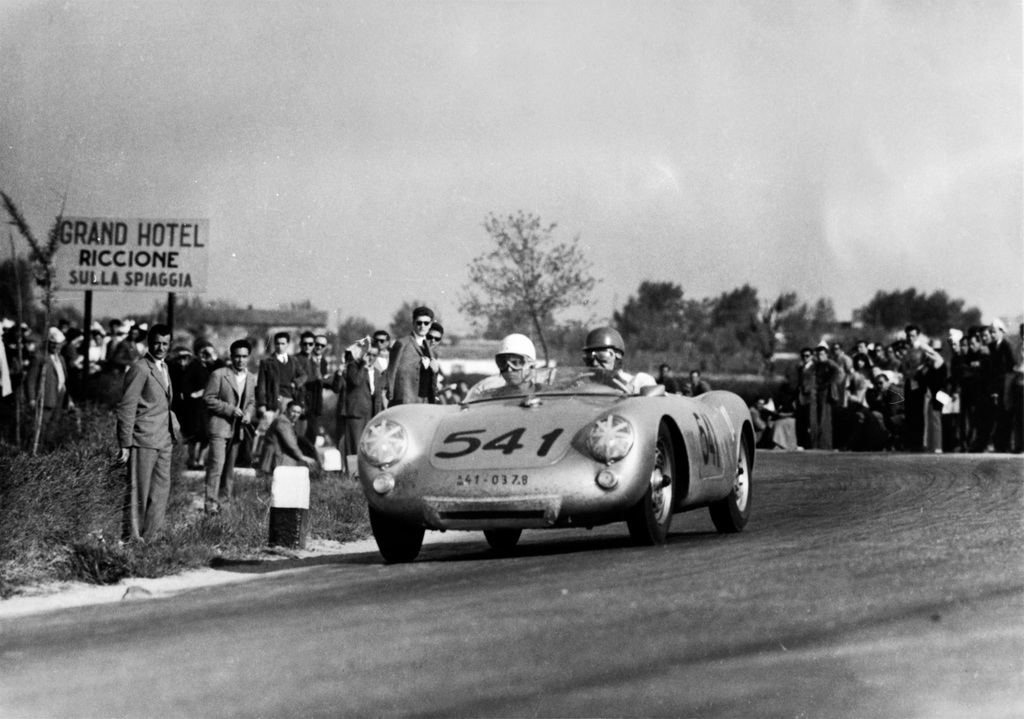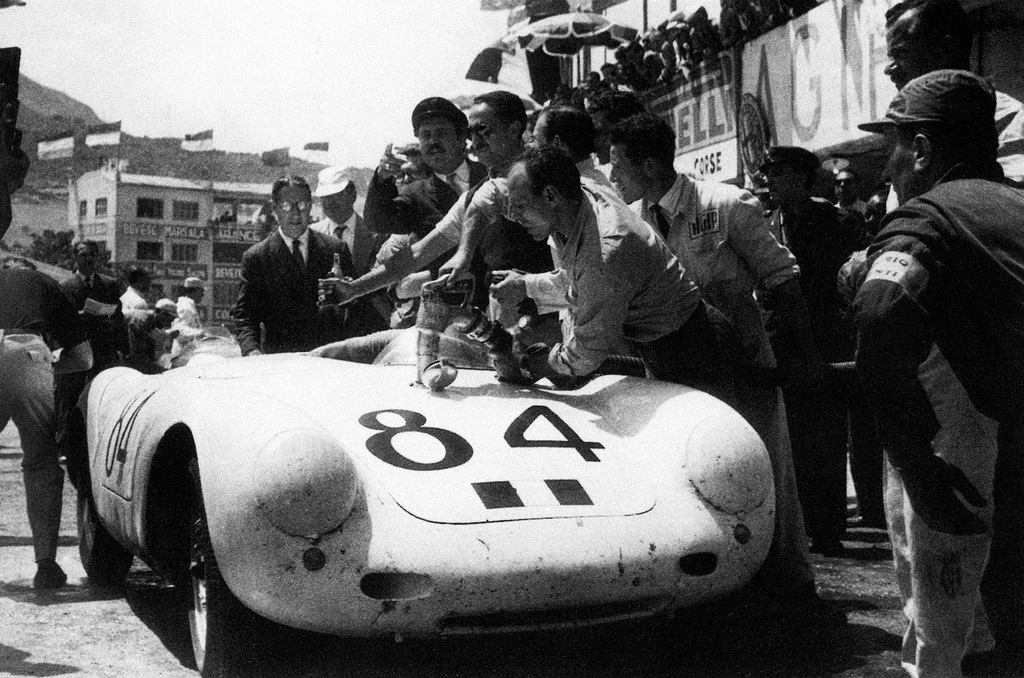Porsche 550A RS Spyder (1956 – 1957)
The 1956 version of the Porsche 550 was known as the 550A. It had a lighter and more rigid spaceframe chassis, and gave Porsche its first overall win in a major sports car racing event, the 1956 Targa Florio. 40 units were made.
The Story
On June 10, 1956, 50 years ago, the company now known as Dr. Ing. h.c. F. Porsche AG, Stuttgart, celebrated one of its biggest and most important racing victories. Italian racing driver Umberto Maglioli was the surprise overall winner in a Porsche 550 A Spyder at what was then the world’s longest-standing and most difficult road race, the Targo Florio, in Sicily.
The young Porsche company gained worldwide recognition with this victory, as it was the first time that a driver in a smaller class of racing vehicle (of up to two litres engine capacity) managed to beat vehicles with a higher cylinder displacement. With an average speed of 90.9 km/h and a lead of nearly 15 minutes on the second place vehicle, Maglioli not only out-classed the competition but also assured the first overall victory for Porsche in the World Championship.
This victory was made all the more surprising because of the fact that the Porsche 550 A Spyder only debuted eleven days before the Targa Florio at a 1,000 kilometre race on the Nurburgring in Germany.
Spurred on by the victory in this class, the Head of Racing at Porsche, Huschke von Hanstein, traveled to Sicily with driver Maglioli and two mechanics to test the open-top Spyder’s competitiveness once again. In contrast to other road races of the time, routes were not closed during training, so the drivers always had to be prepared for traffic and other obstacles. Furthermore, for Porsche it was the first time it took part in this legendary race as, at the time, the Targo Florio was seen as the territory of large Italian racing stables. Maglioli completed the 720 kilometre route without changing drivers in a time of 7:54.52 hours and thanks to the reliability of his Porsche, only pulled into the pit stop to refuel.
The Giant Killers
Source: rmsothebys.com
The 550A was based on Porsche’s first purpose-built racing car, the mid-engined RS 550 Spyder. Appearing at the end of 1956, the 550A differed from its predecessor by use of a full tube spaceframe with several rear supportive cross-members, rather than the heavier welded-up sheet steel internal structure of the 550. The rear swing axles of the 550 were replaced by a new low-pivot arrangement that made handling much more predictable. The complex 1.5-liter four-cam boxer-four designed by Dr. Ernst Fuhrmann had been teased up to about 135 hp at 7,200 rpm with 107 foot-pounds of torque in full racing tune. The close-ratio four-speed transaxle now included an additional “semi-first” gear for starting purposes. Its large finned brake drums were drilled laterally for additional cooling effect, and were easily capable of hauling these agile and featherweight cars down from their factory-claimed top speed of nearly 150 mph.
Construction of the curvaceous and sleek hand-beaten aluminum alloy body shell was outsourced to Karosserie Wendler of Reutlingen. While visually similar to the 550, the 550A could be identified by new louvered access panels behind the doors. There were small air intake ducts in the nose. Most 550As offered a small molded windshield in front of the driver and a headrest fairing, and a metal tonneau cover closed off the passenger side of the spartan cockpit. The finished car weighed just over 1,200 lbs.
The 550A made its first appearance at the 1956 Nürburgring 1000 KM race, where it won its class. That success encouraged the factory to venture into foreign territory. At the 1956 Targa Florio, the Italian ace Umberto Maglioli scored a brilliant overall victory in a solo eight-hour effort. Most of the earlier 550s had been sold to customers in the U.S., and the new “A” derivative also found an eager customer base in North and South America. Teams which had enjoyed steady success with the early cars snapped up the new ones.
Among those was suburban Los Angeles Porsche dealer and racer Jack McAfee. McAfee already had a great deal of experience at the wheel of much more powerful but temperamental Ferraris, driving for the John Edgar stable. But recognizing the 550 Spyder’s superior handling and reliability, he urged Edgar to buy several, including the ex-Works 1956 Sebring 12 Hours class winner that had been driven by Hans Herrmann and Wolfgang von Trips. By then, the little Porsches had already become known as “Giant Killers.”
McAfee used this machine to win the 1956 SCCA Modified F Class championship. When the 550A with its new chassis and improved suspension appeared, McAfee urged Edgar to acquire chassis 0104 from the factory. McAfee, writes Edgar’s son William, had trouble adjusting to the A-model. McAfee chose instead to keep racing his older 550 in spite of a horsepower deficit, but when Phoenix, Arizona, homebuilder and racing enthusiast Stanley Sugarman purchased the Edgar team’s Porsche 550s, McAfee came along, bringing in four-cam whiz Vasek Polak to turn the wrenches.














